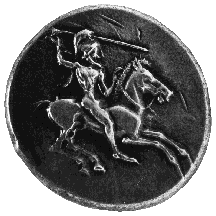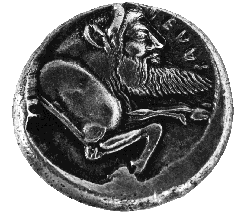



(10) Gela, Sicily (Italy) - AR didrachm, c. 490 B.C., 8.56
g. (inv. 91.023).
Obverse: Helmeted and bearded nude horseman, hurling spear
r.
Reverse: Forepart of man-headed bull swimming r.; ![]() retrograde: Gelas.
retrograde: Gelas.
Provenance: Coin Galleries, 1962.
Bibliography: G.K. Jenkins, The Coinage of Gela, 2
vols. (Berlin 1970), 186 no. 47, pl. 3.
According to Thucydides (History 6.4), the colony of Gela was founded
in 680 B.C. by Rhodians and Cretans. It was located on a fertile plain near
the mouth of the river Gela, for which the city was named. In the late sixth
and early fifth centuries the city flourished under the tyrants Hippokrates
and Gelon, until Gelon seized Syracuse and moved part of the Geloan population
there.
The rider of the obverse probably refers generally to the Geloan aristocracy,
which was known for its horse-breeding and equestrian abilities; the city
was also famous for its cavalry, which the large number of didrachms produced
in this period may have been intended to pay. The type could also refer
more specifically to the tyrant who first introduced the type, either Hippokrates,
whose name means "strong as a horse" or Gelon, who was a hipparch
or cavalry commander under Hippokrates. The nude rider has the sharply emphasized
musculature and the combination of nearly frontal torso and profile legs
that are characteristic of late Archaic art. The man-faced bull, which is
the main coin-type of Gela in the fifth century, is a standard type for
the Greek river god Acheloos, but here as elsewhere it probably represents
the local river god. Its frontal eye in the profile head and highly patterned
beard are also characteristic of Archaic art.
K.L.M.



All contents copyright (c) 1996.
Lawrence University
All rights reserved.